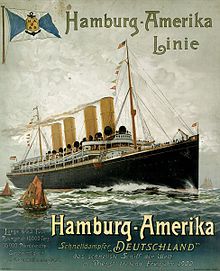Hans Bohrdt
Hans Bohrdt | |
|---|---|
 Hans Bohrdt in his art studio, c1900 | |
| Born | Hans Bohrdt 11 February 1857 |
| Died | 19 December 1945 (aged 88) |
| Nationality | German |
| Occupation | Artist |
Hans Bohrdt (11 February 1857 – 19 December 1945) was a German artist. He was a

Personal life
Bohrdt was born to a comfortably well-off
Bohrdt's love for the sea began when he was 15 after visiting the port of Hamburg.[1]
Bohrdt lived and worked in
Two world wars not only resulted in the decimation of Bohrdt's family but in the number of his works as well. Many are still unaccounted for, including his best-known painting, "Der letzte Mann" ("The Last Man"; 1915), which has been lost since 1924. Innumerable reproductions, both cheap and more lavish, have been reproduced from this work and it has been widely employed for various political purposes.[4]
Career
While many smaller nations could point to a tradition of marine painting stretching back over a period of several hundred years, Germany can only be said to have become seriously engaged in this genre after the country became united in 1871. Marine painting was a young form of art in Germany and came to be "the heartland" of the country. For the art schools of the inland cities of
Bohrdt became a bright star in that firmament of marine painters that shone so brightly during the
He often used tempera for his illustrations, as this medium is particularly suited for reproduction as a print, and he was able to hold his ground for a surprisingly long time against the remorseless advance of photography and the camera.
During the decade prior to World War I, the German Merchant Marine had grown to a size only second to that of the United Kingdom. Not only the vessels themselves, proudly bearing three or four funnels, but even the cargoes and the passenger, were depicted in order to publicize the various shipping lines.[4] Commissions were not long in coming.
World War I

His art had by now become a part of the propaganda apparatus in a Germany resolved on becoming a world power, and in which the Navy was but one of the essential elements. To quote Pompey, and probably Herr Professor Hans Bohrdt, "Navigate necesse est, vivere non".[5]("to sail is necessary, to live is not")[a] Apart from promoting the interests of the Navy and the major shipping lines, his work was established and appreciated amongst a wide circle of affluent buyers. As a member of the Imperial Yacht Club, he was able to exhibit his work, and to obtain work as an illustrator for various Yearbooks. Until the outbreak of the war, artists had been given the opportunity to accompany the Fleet on its worldwide cruises and when security restrictions no longer allowed this, Bohrdt felt that he had lost his connection with the sea. It was a very hard time for him. It was, he said, "like being a Red Indian in New York."
The outcome of the war resulted in the reduction of the merchant fleet, the confiscation of ships and consequently no more commissions. All that remained was for Bohrdt to be a painter of
During the 1920s, the recovery of the
Memorial exhibition
In remembrance of the fiftieth anniversary of his death in 1945, the Museum arranged an exhibition of his work. In addition to those of Bohrdt's paintings, posters, prints and reproductions that it holds in its own collection, the Museum gathered a number of works from both public and private sources. The aim of the organizers was to provide a picture as possible of the last of the great marine painters. The technical virtuosity of this artist who so dearly loved ships and the sea is revealed in all its forms, and considerable attention is given to his skill as an illustrator.
Institute of Prehistoric Archaeology
The Institute of
See also
References
- Notes
- ^ Paraphrase of navigare necesse est, vivere non est necesse ("to sail is necessary; to live is not necessary"); attributed by Plutarch to Gnaeus Pompeius Magnus (Pompey), who, during a severe storm, commanded sailors to bring food from Africa to Rome. Translated from Plutarch's Greek "πλεῖν ἀνάγκη, ζῆν οὐκ ἀνάγκη"
- Sources
- ^ a b Hamburger, Hafen. "Lot:1203".
- ^ a b c d Hattendorf, John (2007). Maritime History. Oxford university press. pp. 303–304.
- ^ Epkenhans, Michael, Hillmann, Jörg & Nägler, Frank Jutland: World War I's Greatest Naval Battle University Press of Kentucky, 23 Sep 2015
- ^ a b c d e Scholl, Lars. "Book Reviews" (PDF).
- ^ a b c d e Meyer, Michael (2 February 2012). "Institute of Prehistoric Archaeology". First University Berlin.
